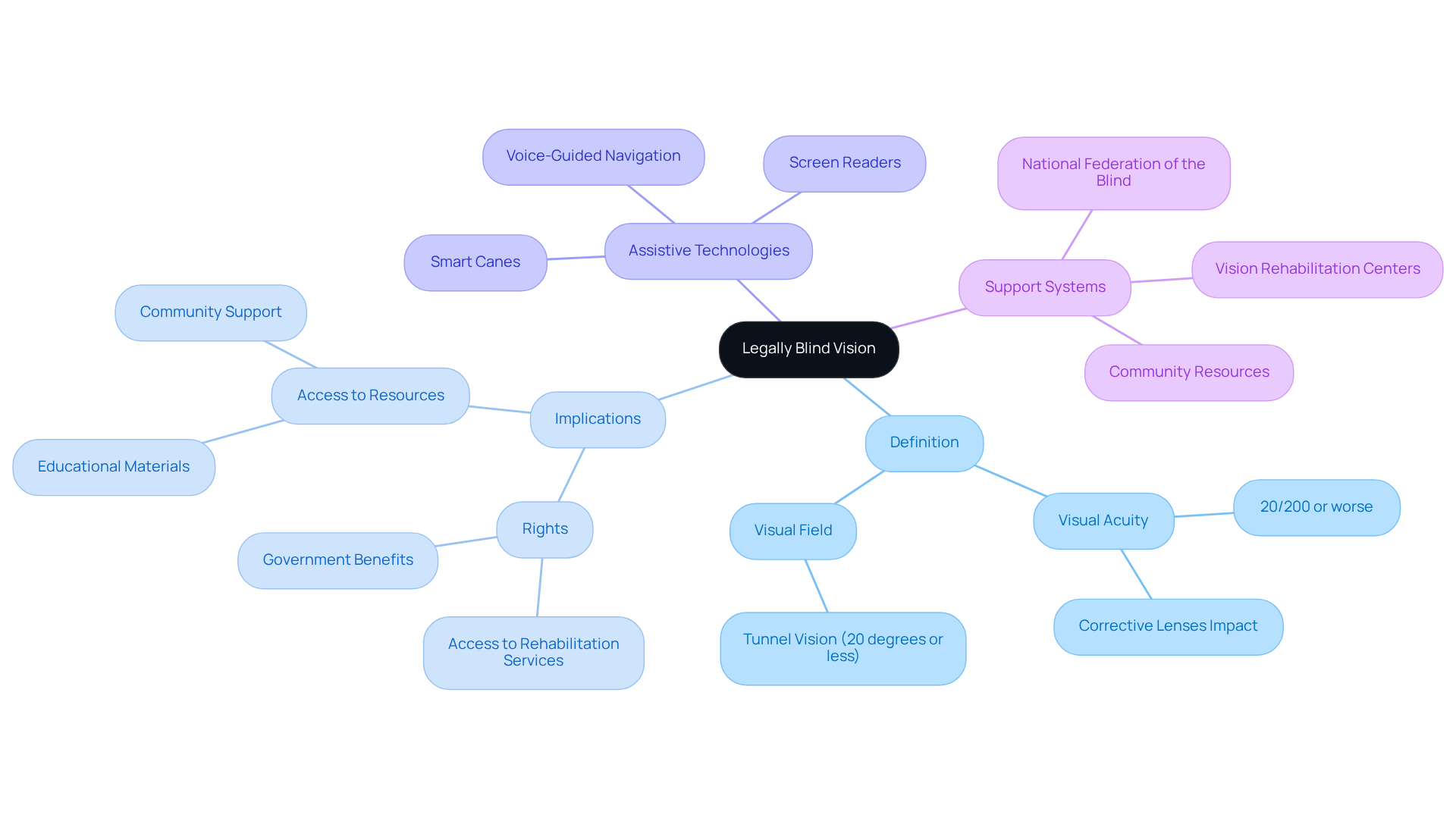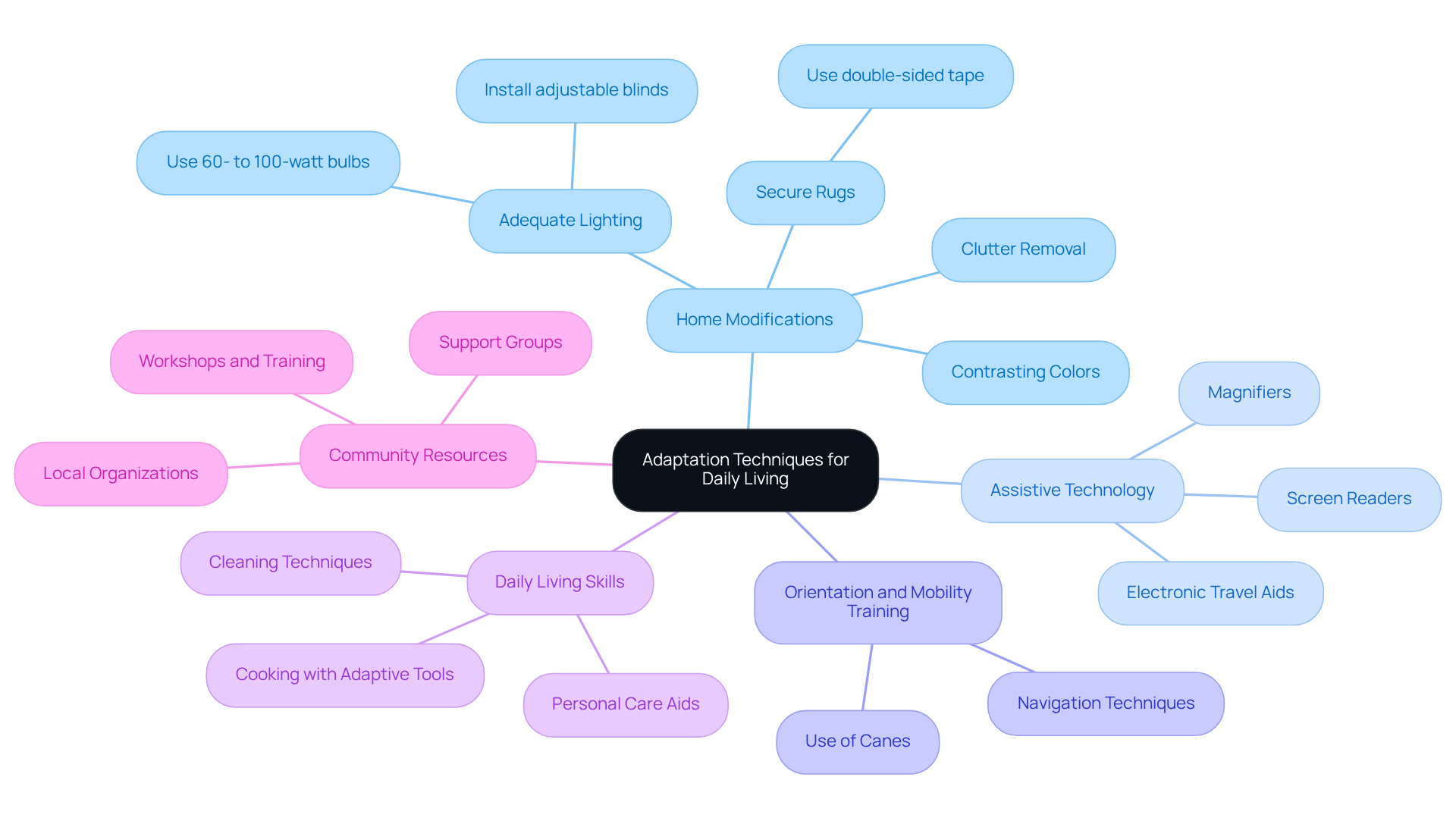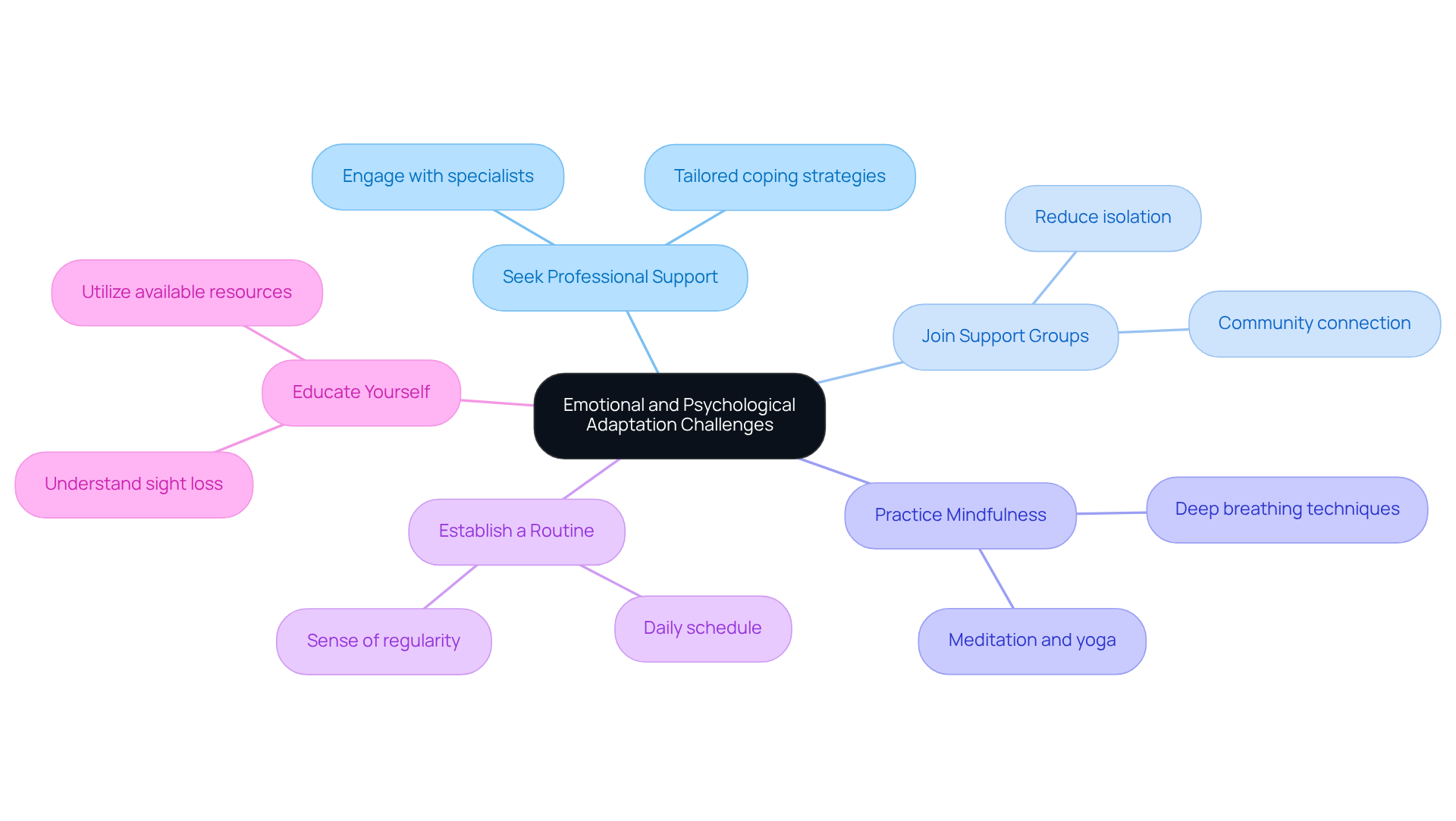Posted by: Northwest Eye in General on July 27, 2025
Overview
Understanding legally blind vision is crucial, as it is defined by a central visual acuity of 20/200 or worse. This condition can significantly impact an individual’s rights and access to essential resources. We recognize that navigating these challenges can be overwhelming. The article outlines various daily living strategies, such as:
- Home modifications
- Assistive technology
- Emotional support techniques
These strategies can enhance independence and improve the quality of life for those with visual impairments. Remember, you are not alone in this journey; we are here to help you find the support you need.
Introduction
Legally blind vision affects millions, and it’s common to feel unsure about its implications. Many remain unaware of the strategies that can enhance daily living. By understanding the nuances of this condition, we can clarify misconceptions and open doors to resources and support systems designed to empower individuals.
How can those navigating life with visual impairments adapt effectively and maintain independence in a world that often overlooks their needs? We are here to help you through this process.
Define Legally Blind Vision and Its Implications
Legally blind vision is defined by a central visual acuity of 20/200 or worse in the better eye, even with corrective lenses. This means that a person can observe at 20 feet what someone with standard sight can perceive at 200 feet. We understand that this definition can feel overwhelming, but it’s important to know that legal impairment can also be characterized by a , commonly referred to as ‘tunnel sight.’
Grasping this definition is vital as it directly influences your rights and access to essential resources, including rehabilitation services and government benefits. It’s common to feel uncertain about what legally blind vision means, but significantly, it does not imply a complete loss of sight. Many individuals maintain some usable vision, which can be enhanced through suitable modifications and assistive technologies. For instance, intelligent canes and voice-guided navigation applications are innovative tools designed to assist you in navigating your surroundings more effectively.
Furthermore, organizations like the National Federation of the Blind provide vital support systems for those with legally blind vision, ensuring access to necessary resources. This understanding fosters a more inclusive perspective on the capabilities of those with visual impairments, allowing you to navigate daily life with greater independence and confidence. Remember, we are here to help you through this process, and together, we can explore the options available to enhance your quality of life.

Explore Adaptation Techniques for Daily Living
Adapting to daily living with legal blindness can feel overwhelming, but there are several techniques that can significantly enhance your independence. Here are some effective strategies that can make a difference:
- Home Modifications: Creating a safe and accessible living environment is essential. Consider removing clutter, using contrasting colors for furniture and walls, and ensuring adequate lighting. Increasing light in low-lit areas is crucial for enhancing visibility and safety. Installing adjustable blinds can help control natural light, while securing rugs with double-sided tape can prevent tripping hazards.
- Assistive Technology: You can leverage devices such as screen readers, magnifiers, video magnifiers, and electronic travel aids to assist with reading and navigation. These tools enable you to access information and improve your daily activities, fostering greater independence.
- Orientation and Mobility Training: Participating in training programs can help you learn how to navigate spaces safely using canes or other mobility aids. This training builds confidence in moving around both familiar and unfamiliar environments, which is crucial for .
- Daily Living Skills: Cultivating abilities such as cooking, cleaning, and personal care with adaptive tools designed for people with vision loss can empower you. For instance, tactile markers on appliances can help identify settings, making daily tasks more manageable.
- Community Resources: Connecting with local organizations that provide assistance and training for people with visual impairments can be incredibly beneficial. These resources offer valuable information, social support, and opportunities for skill enhancement, such as workshops and newsletters, helping to reduce feelings of isolation.
By applying these strategies, you can improve your quality of life and navigate your surroundings with increased confidence and safety. Remember, you are not alone in this journey; we are here to support you every step of the way.

Address Emotional and Psychological Adaptation Challenges
Adjusting to life with legally blind vision often brings emotional and psychological challenges. We understand that this can lead to heightened feelings of anxiety and depression. Studies indicate that individuals with visual impairments are considerably more prone to encounter these mental health concerns, with research demonstrating that 10.7% to 45.2% report clinically significant depressive symptoms. To navigate these challenges effectively, consider the following strategies:
- Seek Professional Support: Engaging with mental health professionals who specialize in vision loss can provide essential coping strategies and emotional support tailored to your individual needs.
- Join Support Groups: Connecting with others who share similar experiences fosters a sense of community and understanding. Support groups create a safe environment to express emotions and learn from each other, significantly diminishing feelings of isolation.
- Practice Mindfulness and Relaxation Techniques: Techniques such as meditation, yoga, and deep breathing can effectively manage stress and anxiety. These practices encourage a focus on the present moment, alleviating worries about the future.
- Establish a Routine: Developing a daily schedule offers organization and a sense of regularity, assisting in reducing sensations of chaos and uncertainty that can accompany sight loss.
- Educate Yourself: Comprehending the nature of your sight loss and the resources available empowers you, reducing feelings of helplessness. Knowledge is a powerful tool in managing emotional responses and enhancing overall well-being. Greater use of low vision services and aids has been associated with fewer depressive symptoms after two years, highlighting the importance of utilizing available resources.
Incorporating these strategies can significantly improve emotional resilience and quality of life for those adjusting to legally blind vision. Remember, we are here to help you through this process.

Conclusion
Legally blind vision encompasses a range of visual impairments that significantly impact daily life. However, it is essential to understand that this condition does not equate to total blindness. The definition of legally blind—having a central visual acuity of 20/200 or worse—highlights the importance of recognizing the capabilities individuals can still possess. With the right adaptations and support, those with legally blind vision can lead fulfilling, independent lives.
We understand that adapting to life with visual impairments can feel overwhelming. This article delves into essential strategies, such as:
- Home modifications
- The use of assistive technology
- Orientation and mobility training
These techniques not only enhance safety and independence but also empower individuals to navigate their environments with confidence. It’s common to face emotional and psychological challenges associated with vision loss. Support networks, professional assistance, and self-care practices can significantly improve resilience and overall well-being.
Ultimately, understanding legally blind vision and implementing effective daily living strategies can transform challenges into opportunities for growth and independence. Embracing available resources, connecting with supportive communities, and utilizing adaptive tools can foster a sense of empowerment. While the journey may be difficult, it is also filled with potential for personal development and enriched life experiences. We are here to help you through this process.
Frequently Asked Questions
What is legally blind vision defined as?
Legally blind vision is defined by a central visual acuity of 20/200 or worse in the better eye, even with corrective lenses. This means that a person can see at 20 feet what someone with standard sight can see at 200 feet.
What does a visual field of fewer than 20 degrees mean?
A visual field of fewer than 20 degrees, often referred to as ‘tunnel sight,’ indicates a significant limitation in peripheral vision.
Does being legally blind mean a complete loss of sight?
No, being legally blind does not imply a complete loss of sight. Many individuals retain some usable vision, which can be enhanced with appropriate modifications and assistive technologies.
What are some assistive technologies available for those with legally blind vision?
Assistive technologies include intelligent canes and voice-guided navigation applications, which help individuals navigate their surroundings more effectively.
How does understanding legally blind vision impact access to resources?
Understanding the definition of legally blind vision is crucial as it directly influences rights and access to essential resources, including rehabilitation services and government benefits.
What support systems are available for individuals with legally blind vision?
Organizations like the National Federation of the Blind provide vital support systems, ensuring access to necessary resources for those with legally blind vision.
How can individuals with legally blind vision navigate daily life?
With the right understanding and resources, individuals with legally blind vision can navigate daily life with greater independence and confidence.






